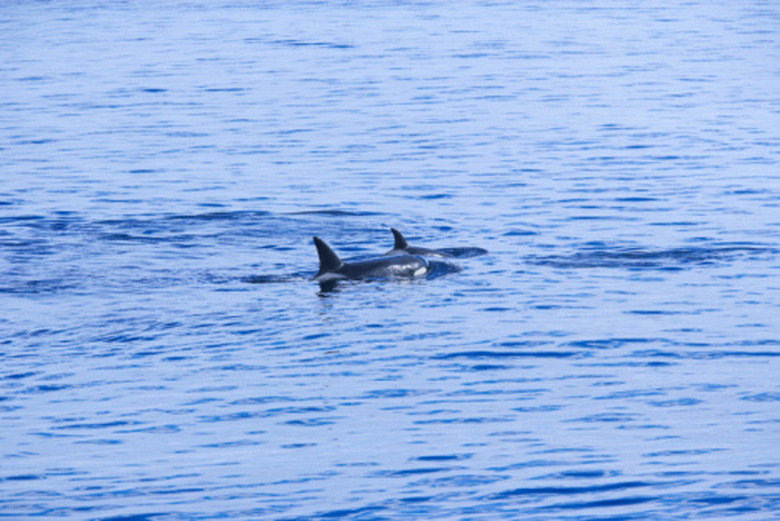List & Describe Four Aquatic Ecosystems
Freshwater and marine environments mark a primary break in aquatic ecosystems; marine environments contain a high level of salinity (salt concentration), whereas freshwater areas usually contain less than 1 percent. Freshwater ecosystems include ponds and lakes as well as rivers and streams. Marine ecosystems include oceans and coral reefs.
Ponds and Lakes
Ponds and Lakes
Ponds and lakes are relatively still bodies of water with little or no current, generally isolated from other bodies of water such as rivers and oceans. They are divided into three distinct zones: littoral, limnetic and profundal. The littoral zone constitutes that which is closest to the shore. With high exposure to sunlight and shallow waters, this is usually the most biologically diverse area in a given lake or pond, housing several species of amphibians, aquatic birds, crustaceans, insects, fish and algae as well as both floating and rooted plants. The limnetic zone comprises the area of a lake/pond that is further from the shore yet closest to the surface of the water. This area is less diverse than the littoral zone, but moreso than the profundal zone due to its high level of exposure to the sun. The profundal zone comprises the deepest area of a pond or lake. Profundal life is almost exclusively dominated by decomposing bacteria and plankton.
Rivers and Streams
Rivers and Streams
Rivers and streams are moving bodies of water that flow from a source, such as a spring or melting glacier, to a mouth, which could be at an ocean, a larger stream or river or some other type of reservoir. As the water travels from source to mouth, the environment of the ecosystem changes drastically. The source of a stream or river has the highest level of purity and oxygen content. Throughout its path, the rushing water gathers debris in its current; by the time the water reaches the mouth, the water becomes murky. As a result, little sunlight penetrates the surface and plant life is scarce. Fish species such as catfish thrive in these areas, able to survive under conditions of low oxygen.
Oceans
Oceans
Oceans are some of the most diverse and geographically expansive ecosystems on earth. Ocean ecosystems are divided into four zones: intertidal, pelagic, benthic and abyssal. The intertidal zone comprises the regions where ocean waters meet land. This zone is very dynamic due to the constant action of tides. As a general rule, species diversity is higher in intertidal zones that are most often submerged by water. Similar to the limnetic zone in lakes, the pelagic zone comprises the open ocean away from the shore yet closer to the surface of the water. A variety of fish, aquatic plants and larger mammals inhabit this region. Benthic and abyssal zones comprise the second-deepest and deepest regions of the ocean, respectively. Due to extreme pressure, darkness and cold temperatures, these zones harbor very different forms of life. To survive a complete lack of sunlight, plants and bacteria in the abyssal zone harvest chemical energy from thermal vents beneath the surface of the ocean floor.
Coral Reefs
Coral Reefs
Coral reef ecosystems are situated in the ocean; but due to their physical and biological composition, they are very distinct from other marine ecosystems. Coral reefs form in shallow waters with warm temperatures. Many of these ecosystems have formed along the shores of continents. Although it may seem like a huge rock, a coral reef actually consists of living animal colonies that fix themselves in a hard, calcium carbonate shell. These colonies have a symbiotic relationship with zooxanthellae, a type of algae that both lives within and provides food for the corals. Although they encompass relatively little area, coral reefs are some of the most biologically diverse ecosystems on earth. An immense variety of sponges, crustaceans, sea anemones, fish, algae, aquatic plants and insects live exclusively in coral reef ecosystems.
Cite This Article
MLA
Higgins, Justin. "List & Describe Four Aquatic Ecosystems" sciencing.com, https://www.sciencing.com/list-describe-four-aquatic-ecosystems-8180393/. 22 November 2019.
APA
Higgins, Justin. (2019, November 22). List & Describe Four Aquatic Ecosystems. sciencing.com. Retrieved from https://www.sciencing.com/list-describe-four-aquatic-ecosystems-8180393/
Chicago
Higgins, Justin. List & Describe Four Aquatic Ecosystems last modified August 30, 2022. https://www.sciencing.com/list-describe-four-aquatic-ecosystems-8180393/
